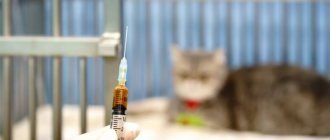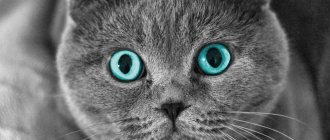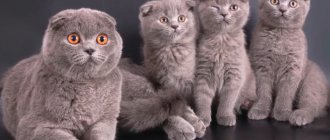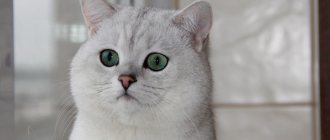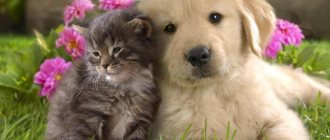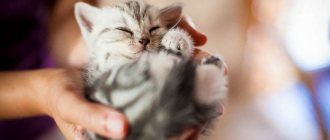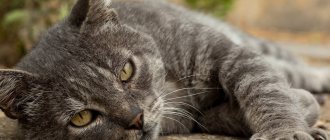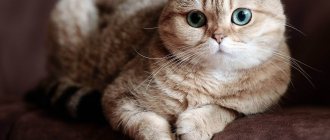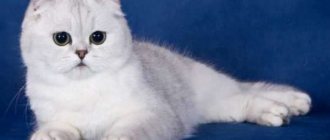The Scottish cat is an extremely popular breed. Its representatives live on average 15 years. There are some individuals that live up to 20 years or more. Thus, on average, the life expectancy of Scottish fold and straight-eared cats and cats is approximately the same as that of other breeds.
But this only concerns the question of how long Scottish cats and fold-eared and straight-eared cats live at home. Such a tailed animal will live much less on the street, and here's why. At home, the food is better, the care is better, the veterinarian is available when needed, affection and care are all around.
Article continues after advertisement
Another significant factor is the birth of kittens. Sterile cats have a much longer life expectancy, this has been proven by scientists. Animals that are not neutered live shorter lives on average. But, if a cat periodically gives birth to kittens at home, this happens with better nutrition and medical care, and she does not do this as often as in nature, then she also has a good chance of living a long time. In street conditions, cats give birth 3-4 times a year, which depletes the body, and as a result, including this, life expectancy is only 5-7 years. This is normal, because otherwise we would have had an overpopulation of cats on our planet long ago.
How many years Scottish Fold cats (Scottish Folds and Highland Folds) live also depends on the presence or absence of musculoskeletal diseases. The thing is that fold-eared cats are predisposed to joint diseases, which can sometimes result in a serious problem. The culprit is the lop ear gene, which deforms the cartilage. Straights don't have this problem.
But let's not talk about the bad. Let's assume that you have chosen a healthy kitten, keep it in good conditions, groom it and cherish it in every possible way. Under such conditions, the life expectancy of Scottish fold cats can easily reach 20 years. To bring it closer to this mark, you need the following:
- choose the right breeder, buy a healthy kitten, preferably a girl, because... females live about 2 years longer than males;
- get all vaccinations on time, but only with high-quality vaccines;
- when a cat appears in the house, eliminate all dangers that may threaten its health;
- sterilize (castrate);
- do not let him go outside on his own;
- feed raw natural food according to a balanced menu or purchase the highest class food;
- take him to the veterinarian for examination on time;
- often play with the cat so that he has good physical activity;
- choose only high-quality and safe care items and toys;
- truly love your pet.
Subject to these conditions, you get the maximum chance that you will live happily ever after with your cat.
History of the breed
The history of the discovery of the Scottish Fold breed is very interesting. In the early 1960s, a man named William Ross was walking in a place called Angus, in Scotland. There, on one of the farms, he met an unusual cat, whose ears were folded down, which gave the impression that the animal’s head had a regular round shape. The man persuaded the pet's owner to sell the animal, and Scottish Fold cats became known outside not only Scotland, but also the mainland.
Scottish fold cat
In 1978, the breed was presented at the World Pet Show in the USA. In 1993, the Scottish Fold was officially registered.
Tags
Cats Cats Dog breeds Cat breeds Rodent breeds Dog breeds Cat breeds Rodent breeds Dog breeds Life expectancy of dogs Life expectancy of cats Life expectancy of rodents Life expectancy of dogs Life expectancy of cats Life expectancy of rodents Life expectancy of dogs Life expectancy of cats Life expectancy of rodents Life expectancy of dogs for cats Grooming of cats Feeding cats Sterilization of cats life of cats for cats Grooming of cats Feeding of cats Sterilization of cats Pets Fold-eared pets are prone to the pet's body.
petread
Relationships with other animals and children
Scottish Folds are obedient, non-hyperactive animals. They treat children warmly, play and communicate with them without letting out their claws. They are indifferent to other people's children who come to visit, but they will humbly allow themselves to be touched and stroked.
Scottish Folds do not conflict with other animals, allowing them to dominate.
There are few conflicts with these pets, and they are rarely considered direct initiators of conflicts. Scottish Fold cats are tactful and forgiving, not subject to impulsive reactions. Behavior that goes beyond the boundaries is observed in them extremely rarely, much less often than in representatives of other breeds.
Fold cat: characteristic features
The head of this cat is predominantly round in shape with a slightly protruding jaw. A characteristic feature of the Scottish Fold breed (also called Scottish Fold) is prominent cheeks and pronounced whisker pads.
These cats have a short, thick neck, and the nose is also short, with a slight hump. A specific eye color is not assigned to fold-eared cats, since this is influenced by color. These cute animals have round eyes.
It’s worth mentioning the paws of a fold-eared cat. The limbs have a small round shape. Thus, the hind legs are often thickened, which sometimes creates an obstacle to normal movement and brings minor discomfort to the owners.
Interesting information about the representatives of the breed
Highland fold (Scottish fold longhair cat)
Scottish cats have not only an unusual appearance, but also a special behavior. They can often stand on their hind legs for a long time, which they do not to attract attention to themselves, but to stretch their spine. Fold-eared pets are also afraid of heights, so they do not climb onto cabinets and curtains.
Some representatives of the breed sometimes have erect ears, so they are confused with another Scottish Straight breed. This can lead to unpleasant consequences, as inexperienced owners often mix straight-eared folds with straights, and sick mixed-breed kittens are born.
How to choose a Scottish Straight kitten
Arm yourself with the breed standard and visit a Scottish Straight breeder in an informal setting to see with your own eyes the conditions in which the kittens grow up. Well-groomed Scottish dogs have lush, shiny coats and clear, open eyes. The abdomen of a normally developing baby is soft, and not swollen to the point of a ball. A healthy kitten's tail should be clean, and its fur should not smell bad or sparkle with bald spots.
Observe the behavior of the young Scottish Straight. A trouble-free baby willingly joins in the gameplay and shows interest. Kittens that are bored and unresponsive are most likely unhealthy or depressed. Observing the character of the babies’ parents is also a good safety net, since it is from them that the animals inherit their temperamental characteristics.
What affects the duration
There are several factors that can significantly shorten the lifespan of a Scottish cat:
- Weak bones. This breed is prone to problems with bone and cartilage development. Such problems can appear in adulthood.
- Tendency to obesity. An unbalanced diet quickly leads to excess weight gain, and this, in turn, negatively affects the functioning of the heart and liver.
- In the long-haired variety (Highland Straight), without regular combing, the hair becomes so dense that it prevents the animal from moving. In advanced cases, this even leads to physical inactivity, that is, weakening of muscles due to lack of mobility. In addition, dense clumps of such wool are difficult to remove from the animal’s stomach and cause disturbances in the gastrointestinal tract.
- The lop-eared type is especially susceptible to problems with the ears - wax and dirt quickly accumulate in them. If they are not regularly examined, the onset of the inflammatory process or the appearance of mites may go unnoticed and lead to serious complications.
Weight table by month
The Scottish Straight weight gain graph is clearly demonstrated in the table by month.
| Age | Female (weight in kilograms) | Male |
| 1 month | 0.3-0.65 g | 0.45-0.75 g |
| 2 | 0.45-0.8 g | 0.8-1.6 |
| 3 | 1.25-1.7 | 1.3-2.4 |
| 4 | 1.7-2.35 | 2.1-3.8 |
| 5 | 2.25-3.1 | 2.45-4.2 |
| 6 | 2.3-3.5 | 3.1-5.5 |
| 8 | 2.9-4.3 | 3.4-6 |
| 10 | 3.1-4.6 | 4.2-7.2 |
| 1 year | 3.2-5.3 | 4.6-7.4 |
| 2 and older | 3.4-5.6 | 5.3-8.2 |
Appearance
British Fold is a Scottish breed of cat.
Scottish Folds have a fairly well-fed and powerful body. Cats come in different colors, the most popular being gray fur. The color of cats is divided into two groups: plain and patterned.
Patterned marbled color
Solid colors of fur are classified as monochromatic: white, black, gray, blue, red, chocolate, lilac.
The patterned colors include the following:
- spotted, round or oval-shaped spots on the back, sides and tail;
- marble, patterns in the form of a ring and a half ring;
- colorful, small spots and dots on the limbs and head, which are much darker and more contrasting against the background of the main color of the fur;
- chinchilla, a small part of the hairs is colored white or black, for example, completely blue cats may have white hairs on the abdomen or limbs.
Dimensions and weight of fold cats
Scottish cats are usually medium in size, but their bodies are stocky and muscular. The average weight of cats is about 4-7 kilograms, and cats are much heavier, ranging from 7 to 10 kg.
Ears
The ears are set wide on the head, “hanging” towards the bottom, but turned forward. They are small in size and rounded at the ends.
Eyes and nose
Large folded eyes with a perfect round shape. They are quite wide open, which gives the impression that the cat looks surprised.
The short nose is wide and straight. The animal has an excellent sense of smell, which makes British cats one of the best hunters among domestic cat breeds.
Torso and limbs
The chest, shoulders and back are wide compared to the rest of the body, the neck is short. The hind legs are short but muscular. The tail is also short and rounded at the tip.
Head
The cat's wide and massive head is shaped like a circle, and its chin is firm. The cheeks of a pet are wide and plump, in addition, the whisker pads are also round. The mustache is long and clearly defined.
British Folds love to stand on their hind legs.
Standards
The weight of a Scottish Straight individual is 3-3.5 kg, rarely more.
| Standard | Description |
| Head | The shape of the skull is round, with convex cheeks and forehead. The cheekbones are clearly defined (more so in cats than in cats), the chin is strong. The whisker pads are oval and plump. The nose is short, with a wide bridge and no noticeable stop. |
| Eyes | Large, widely spaced. The iris can be any color. |
| Ears | Large, wide at the base and with rounded tips. The outside is abundantly pubescent, the inside is less, but lush panicles, hard and long, grow on the skin. |
| Torso | Muscular, long, large, but with soft smooth lines. The neck is muscular and short. |
| Limbs | Long, strong, with oval and elastic legs. |
| Tail | Long, dense, reaching the shoulder blades in length. |
| Wool | The coat is thick, dense, and plush to the touch. It can be either short or medium length. Undercoat is present. |
Serious defects are considered:
- turned out toes;
- cryptorchidism;
- creases on the tail;
- short tail;
- small eyes;
- explicit “stop”;
- flat forehead;
- too wide ears.
Exterior Features
Those who want to know how long British cats live at home would do well to familiarize themselves with the breed standard. These are medium or large, broad-boned, squat animals with well-developed muscles. A distinctive feature of these individuals is their beautiful plush fur. On the large round head are widely set, slightly rounded ears. The color of the eyes depends on the shade of the fur.
The standard provides several possible coat tones. Representatives of this breed can have tortoiseshell, bright red, lilac, black, white, chocolate, cream and blue-gray fur. A characteristic feature of the British is considered to be a muscular body with a wide back, turning into a thick, tapering tail.
Those who want to understand how long a British cat lives will be interested in how these animals behave. Let us immediately note that the luxurious handsome men have a rather friendly disposition. But, despite their easy-going nature, they have their own opinions.
During the first meeting, this aristocrat can give the impression of an extremely unfriendly creature. But once she understands who she has to deal with, she will become more sociable. In addition, representatives of this breed are very freedom-loving and will not tolerate inconvenience. They will never lie next to their owner against their will. The British are very active and playful. Even at an advanced age, they will not refuse to run after the ball.
Character and behavioral characteristics
Along with the external description, the character of the fold-eared breed also differs from other representatives of the cat world. These are very well-mannered, proud and calm cats. Scottish cats are aristocrats in their origin and behavior. They immediately understand what people want from them and obey them. However, if they don’t like something, they can show their stubborn and unapproachable nature.
Golden chinchilla - a cat with a special character
Sometimes these cats stretch their legs forward and take a strange pose, as if they are meditating. They love to sleep on their backs rather than curled up in a ball. Scots love to have their fur brushed or massaged.
Representatives of the Scottish Fold breed meow very rarely and quietly. They speak only when absolutely necessary and are not used to disturbing others needlessly. Moreover, unlike other representatives of the cat family, fold-eared cats do not impose themselves on their owners asking them to caress and stroke them. They love to be close, but not constantly sit in a person's arms.
Interesting! While still kittens, Folds do not cause much trouble to their owners. However, Scottish kittens love to hide small objects from their owners in corners and secluded places.
Children and other animals
Fold cats are the most loyal and loving. They become very attached and most importantly respect their owners. The breed is famous for its ability to find a common language not only with all representatives and friends of the family in which they live, but also with other pets.
Representatives of this breed get along very well with children. They are attentive to the child and do not fight or scratch. Fold-eared Scots can become the most devoted and well-mannered friends for children for many years.
Scottish Folds are good with children
Scottish Straight character
It would be a big mistake to label all Scottish Straights as phlegmatic philosophers. Moreover, among these imposing cats, sometimes there are real livelies who love to chase a wind-up mouse and measure their strength with the owner. And yet, for the most part, Scottish straight cats do not have a violent temperament. Proud and serious, they cannot stand total control and are unlikely to allow themselves to be squeezed into a semi-conscious state. This, of course, does not make Scottish ascetics and sad hermits, they just require a little more independence and personal space than representatives of other breeds. Straights prefer to spend their free time in peace and quiet, lounging on the couch and learning Zen in the Buddha pose.
Squeezing the cat
The Scots are happy to make contact and join in the games, but only when they want to. In all other cases, it is better to leave the cat alone. The peak of motor activity of straight-eared Scottish cats occurs in the first year of their life. By the way, Scottish babies in their playfulness and restlessness are practically no different from ordinary outbred kittens. Adults, on the contrary, are famous for their exemplary behavior and patience. If you go on a visit for a couple of hours, leaving the Straight alone, he will easily survive it. However, weeks of loneliness, interrupted by rare raids from the owner, will not improve the character of the animal. As for the pacifying purr of straight-eared Scottish cats, it still needs to be earned: cats purr infrequently, and meow only in exceptional, from their own point of view, cases. Scottish Straights accept strangers and noisy groups of guests in a completely “secular” way, which means without unnecessary suspicion and aggression, but also without wild delight.
Scottish Straight cats are emotionally stable and not subject to sudden mood swings. However, exceptions to the general rule have not been canceled, so amateur videos with catchy headlines like: “The most disgruntled Scottish in the world” periodically appear on the Internet. In addition, straights are characterized by amazing persistence. If a cat wants something, he will definitely achieve it, following on the heels of the owner, and sometimes reinforcing his actions with annoying meows.
Detrimental environmental factors
Scottish cats were bred as a decorative breed; they are not adapted to life on the street. Cats do not tolerate temperature changes well. The danger for them is drafts, which can cause colds.
Scottish Folds have a delicate nervous system. They do not tolerate stressful situations well. Fear and anxiety should not be present in a cat's life. At the same time, representatives of the cat family need personal space and freedom.
Participation in the process of reproduction is important for all animals. But statistics show that spayed and neutered male cats live, on average, several years longer.
An important factor is heredity. You can study your pet's pedigree. If a cat’s ancestors lived a life close to 20 years, then he has every chance of reaching this milestone.
How to extend the life of a Scottish cat
The longevity of a pet is ensured by:
- Regular and timely vaccinations. Regardless of where your pet is at home or outside, there is always a risk of infection. The apartment is not isolated from viruses and germs. Vaccination will protect the animal from possible risks.
- Balanced diet. If a cat eats industrial food, it is desirable that it be premium or super premium. Natural food should contain a lot of protein. Raw and boiled vegetables are beneficial. It is necessary to ensure that there is always clean water in the drinking bowl.
- Hygiene and care. Since childhood, the pet should be accustomed to mandatory hygiene procedures (trimming nails, brushing teeth, combing out old fur and tangles, washing with a special shampoo, treating eyes and ears.
- Preventative visits to the veterinarian. It is advisable to visit a doctor every six months. The veterinarian will prescribe a suitable diet and mineral supplements to strengthen the skeleton and cartilage tissue.
- Activity. Scottish cats need reasonable exercise. The owner’s responsibility is to provide the pet with the opportunity to run and jump, while avoiding injury. It is advisable to buy toys for him. During the game, the cat will grind down its teeth and claws.
- Sterilization. Neutered Scottish cats live 2-3 years longer.
The owner should spend as much time as possible with the animal and monitor its health. At the first suspicion of illness or injury to the cat, you should urgently see a doctor. In 90% of cases, this makes it possible to prevent the development of serious pathologies and consequences that can shorten the life of a Scot.
Education and training
It is necessary to raise a Scottish kitten, taking into account the character and habits of this breed. Raising a pet should be carried out according to two principles:
- instilling cleanliness in the kitten;
- teaching subordination - making it clear that the owner must be obeyed.
The kitten must be toilet trained, sit or lie still when brushing its fur. It is necessary to make it clear that all care activities are necessary for the normal functioning of the pet. The cat must know that sharpening its claws on furniture, climbing on the kitchen table and relieving itself in flower pots is prohibited.
Important! If your pet copes with the assigned tasks, you should definitely praise him and reward him with treats.
It is necessary to train a cat when the pet is interested in communicating with the owner. To develop the reflex, you need to give commands before feeding or walking the cat. Simple commands like “Ugh!” or “You can’t!” it needs to be repeated as necessary so that the cat knows what can and cannot be done.
Symptoms
Let's look at how allergies to cats manifest themselves. In fact, the manifestations of an allergic reaction can be of different types.
Respiratory symptoms of a cat allergy:
- nasal congestion and allergic rhinitis;
- burning sensation and itching in the throat and nose;
- cough and sneezing;
- dyspnea;
- swelling of the nasopharynx.
Against the background of these symptoms, general weakness and even fever may occur.
The intensity of respiratory symptoms varies from person to person. For some, they appear after prolonged contact with a cat, while for others, an attack can begin literally when the animal appears.
Manifestations of a skin allergic reaction to cats:
- the appearance of irritation and itching on the skin;
- burning and itching;
- rash, blistering and redness.
Skin symptoms usually appear upon direct contact with the animal. If an allergic reaction is expressed only in this way, then it will be enough for the patient to simply minimize the risks of their manifestation - it is enough to exclude contacts with felines.
Allergic manifestations of food nature:
- nausea;
- pain syndrome in the stomach.
If an allergen gets into food, symptoms can manifest themselves in this way - a general deterioration in the condition, the urge to vomit and pain in the stomach. In this case, it is also important not to delay your visit to the doctor, so that the specialist has the opportunity to make the correct diagnosis as early as possible.
Other cat allergy symptoms:
- headache;
- lethargy and irritability;
- the appearance of swelling in the eye area, profuse lacrimation.
It should be noted that all of the listed symptoms are not unique and may indicate the development of another disease. Therefore, the key point is accurate diagnosis and determination of the cause of the symptoms that appear.
Are you experiencing cat allergy symptoms?
Only a doctor can accurately diagnose the disease. Don't delay your consultation - call
Health
Scottish cats have a genetic defect. It was he who led to such a feature of their ears. Due to the presence of this gene, they are also predisposed to diseases of the musculoskeletal system and joints. Scottish cats often develop osteochondrodysplasia. This disease is characterized by curvature of the spine and limbs, impaired mobility of the tail. This pathology cannot be treated and is what most often causes a reduction in the life expectancy of Scottish cats. These animals are also prone to ear diseases. They often get ear mites and inflammation develops. It is necessary to regularly take your pet to the veterinarian and vaccinate it. With proper care and following all doctor's recommendations, a Scottish cat can live about 20 years.
Author: Oskina Oksana Valentinovna
Caring for your ears
Your pet's closed ears look very cute. But due to their shape, they are susceptible to contamination and bacterial growth. The pet cannot clean them on its own. Pathogenic bacteria can cause enormous harm to a cat's health. Therefore, the ears must be clean. In addition, ticks love to get into floppy ears. If you take your cat to the country and it regularly walks, be sure to check the animal for ticks. If you find an insect, it is better to contact a veterinarian rather than treat it yourself.
Scottishfold care
Like other pets, Scottish cats require regular and proper care. The eyes of fold-eared cats need to be examined; they need to be cleaned with a cotton pad as they become dirty. Fold does not have the habit of damaging furniture with his claws, but for the safety of the cat itself, it is necessary to trim its claws when they grow back.
Fold cats are usually bathed 2 times a month; in winter, once a month is sufficient. But the fur needs to be combed more often to prevent the formation of tangles. The wool is combed first in the direction, then against the growth.
Additional Information! The Scottish cat is not distinguished by a capricious and pugnacious disposition, so the procedure for combing its fur is carried out without problems. Moreover, four-legged friends love this event and will lie quietly, perhaps purring with pleasure.
What you need to know about Scottish Fold ears
Scottish Fold kittens are born with straight ears. Only in the process of growth, in the third or fourth week from birth, do their ears begin to fall and take the form of a bend or crease characteristic of the breed.
It is necessary to examine the animal’s ears at least twice a month. You just need to carry out the procedure carefully so as not to cause pain or damage your pet’s unusually shaped ears.
Note! Rarely do Scottish Folds have ears that “stand up” as they grow. In such cases, it becomes impossible to distinguish them from another similar Scottish Straight breed.
“Vulnerable” places of Scottish folds
Scottish Fold is classified as an undemanding strong breed. But every artificial species has “vulnerable” places.
What problems do owners of fold-eared cats encounter?
- Diseases of the musculoskeletal system. In adulthood, problems with the development of bone and cartilage tissue begin.
- Cats easily gain excess weight as a result of a sedentary lifestyle and an unbalanced diet. This gives impetus to liver and heart dysfunction, and the risk of serious problems increases.
- The ear is the weakest point of the Scottish Folds. Responsible owners of fold-eared cats regularly inspect their pets' ears and clean them of dirt and wax. Otherwise, an inflammatory process appears and enters the chronic stage.
- Long-haired cats suffer from the appearance of dense mats due to insufficient coat care. This reduces mobility and negatively affects muscle tissue throughout the body.
There are diseases that are most often inherited by Folds.
What diseases do cat owners face:
- Osteochondrodysplasia. Health problems can be identified by lameness and hardening of the tail.
- Osteoarthritis is joint stiffness.
- Hypertrophic cardiomyopathy is a problem with the functioning of the heart.
- Polycystic kidney disease.
Important! If crossed incorrectly, the risk of bone problems increases.
Care and maintenance
Scottish Straights are typical domestic cats for whom walks in the fresh air are pleasant entertainment, but not more than that. This is why Scots are considered ideal pets for homebodies. In everyday life, straights are unpretentious and rarely cause trouble. Take your animal for routine veterinary examinations, carry out timely vaccinations, use high-quality food - and straight-eared Scottish cats will not create any problems for you.
Hygiene
Scottish Straight loves its owner
Scottish Straight cats are very clean cats that carefully monitor the condition of their own fur, but they still need to be bathed from time to time. Usually, cats are washed as their “coat” gets dirty, using shampoo from the pharmacy. At the end of the procedure, you can apply a balm to the coat. When bathing, make sure that water does not get into the animal’s ears and be sure to protect the wet pet from drafts.
Owners of show-class specimens preparing to participate in exhibitions will have to work a little harder. In particular, a few months before the event, the cat begins to be washed daily to completely remove dead cells from its skin and stimulate the growth of new fur. In addition, you will have to spend money on a variety of professional coat care products, ranging from degreasing paste to texturizing conditioner. Brush Scottish cats once a week with a short hair brush. Claws are trimmed as they grow. Be sure to monitor the condition of your cat's eyes and remove unwanted discharge with a swab soaked in hygiene lotion.
Feeding
The diet of Scottish Straights is no different from the “menu” of their fold-eared counterparts. Just like folds, Scottish straight-eared cats benefit from lean meat, offal, boiled sea fish, fermented milk products, and egg yolk. In addition, the animal’s diet should include vegetables (raw or stewed), cereals and sprouted wheat.
Prohibited
- Fat meat.
- Beans and potatoes.
- Bones.
- Sweets, spices, smoked foods.
- Garlic and onion.
- Bread.
- River fish.
- Citrus.
- Mushrooms.
- Raw eggs.
Curious Scottish Straight
In serious nurseries, Scottish Straight kittens are sold starting from the age of three months. During this period of life, the baby no longer feeds on mother's milk, which means it is able to eat the same food as an adult animal.
An important point: natural-fed straight cats do not receive enough of the vital microelements. Vitamin and mineral complexes, which can be purchased at a veterinary pharmacy, solve this problem.
Scottish Fold cats can also be fed commercial food if you are willing to spend money on its non-budget varieties - “premium”, “super premium” and “holistic”. An ideal cut for a Scottish dog should contain at least 26% protein and about 9% fat. It is advisable that the food does not contain wheat and corn, which can cause allergies in the cat. From this point of view, the most useful options for “drying” can be considered the Canadian Acana Pacifica Cat and the American Earthborn Holistic.
Three-month-old Scots are fed up to 6 times a day, six-month-old kittens eat 5 times a day, nine-month-old kittens - 4 times. One-year-old individuals are considered adults, so 2-3 meals are enough for them.
Feeding the fold breed
The content and quality of the diet is of particular importance for the active and healthy growth of the cat and for maintaining the necessary muscle mass of its body. You should not feed your pets cheap food; it is better to choose premium food.
In addition to nutrition, Scottish Folds need to be given vitamins and mineral supplements. They are especially necessary when feeding the Scots cat with natural products. And when feeding special cat food, vitamins are usually not needed, since the ready-made food already contains all the necessary beneficial nutrients and vitamins.
The diet of kittens is different from that of adult cats.
Natural nutrition
The menu of an adult Scottish Fold cat should include the following natural products:
- boiled meat, preferably chicken and beef;
- raw or steamed lean fish without spices and salt, from which all bones must be carefully removed;
- cereals: boiled rice and oatmeal;
- of dairy products for adult cats, only boiled milk is useful;
- homemade vegetables and herbs.
What to feed a Scottish kitten:
- low-fat boiled minced chicken;
- boiled lean fish fillet;
- kittens can be given kefir, milk and low-fat sour cream from dairy products;
- rice boiled in water and oatmeal, into which you can crumble a little hard-boiled chicken egg;
- home-grown vegetables and cat grass grown at home.
Important! You should not feed Scottish Fold cats lamb, pork and other meats with a high fat content. Also, salt, seasonings and spices are strictly contraindicated for Scottish Folds.
What to feed?
There are several food options for Scottish Straights.
- Ready meals. Today, stores offer a large number of options for ready-made mixtures. Manufacturers create menus for pets based on all the substances and vitamins they need. However, it is worth noting that in addition, some manufacturers may add addictive substances. If a pet eats such food for a long time, then over time it will no longer eat anything but it.
- Homemade food. It consists of preparing individual dishes for your pet with your own hands. This is the best option for kittens. However, it requires a lot of free time.
- Combined menu. Involves a mixture of store-bought and homemade food.
The choice of food type depends on three factors:
- the time that owners can devote to cooking;
- pet health;
- what the animal is used to eating.
Let's take a closer look at how each type of nutrition differs.
To create a natural menu, you will need to study the literature on what vitamins your little friend needs. Typically, a natural menu includes steamed or raw vegetables, fish, eggs, dairy products, poultry, offal, cereals and porridges. Since cats are still predators, the basis of their diet should be meat and protein (it is necessary to strengthen the skeleton).
Ready-made food can be divided into dry and wet (food in bags). And according to quality they are divided:
- for premium feed;
- super-premium class;
- economy class.
Since Scots are very sensitive to the composition of food, economy class food is not suitable for them. They can be used once, for a variety of nutrition.
To maintain your pet’s body, it is necessary to supplement its diet with vitamin complexes. They are sold in veterinary clinics or pharmacies. There are vitamin complexes created specifically for the Scottish breed. In this matter, there is no difference between the fold-eared and straight-eared representatives of the breed. In addition, it is worth growing special cat grass on the windowsill. The seeds of this herb are sold in pet stores. This will allow the animal to always receive fresh vitamins. You should not feed your pet grass grown outside, as there may be parasite larvae on the stems.
Special attention should be paid to drinking water. The pet should always have access to it
You can pour water into a bowl or a special drinking bowl. Many pets prefer to drink tap water. Representatives of the Scottish Straight breed are also noted for their love of cold tea.
Proper nutrition and diet
A balanced diet is the key to health. Consult with a specialist to choose the right food for your cat. Good food contains all the necessary vitamins and you do not have to purchase additional vitamins. The food can treat some diseases common to cats of this breed. Don't experiment with Scotch's diet. After all, it directly affects the health of the pet. It is preferable to feed cats with high-quality food. Under no circumstances should natural food be mixed with feed. This is stressful for any cat's digestive system.
Pros and cons of the breed
Scottish Folds are ideal pets; they are smart, well-mannered, loyal, friendly and calm. But most often, it is the appearance of the “teddy bear” that attracts attention when choosing a breed. But it is still worth paying attention to several disadvantages of this type of cat.
Advantages of the Scottish Fold breed:
- exceptional aristocratic character;
- beautiful plush appearance;
- loyalty and non-intrusiveness towards the owner;
- cleanliness and good manners;
- get along well with small children, do not offend or attack them;
- are calm friends with other pets;
- quickly adapt to new conditions and terrain;
- do not require constant and special care;
- sometimes folds behave strangely and funnyly, take funny and strange poses.
Disadvantages of fold-eared cats:
- due to the structure of the ears characteristic of the breed, cleaning them from accumulated wax is very difficult;
- very high cost when compared with other cat breeds;
- Due to gene mutations in the body, cats can have congenital diseases: osteochondrodystrophy and hemophilia.
Important! In addition to bone deformation and blood clotting disorders, Scottish Folds can have problems with the functioning and structure of internal organs. Therefore, it is necessary to visit the veterinarian regularly.
Kittens must be selected according to certain criteria
What ailments are there?
Diseases significantly shorten the life of fold-eared cats, so they may not live long depending on the disease. The most common:
- Osteochondrodysplasia. Characterized by skeletal deformation. Highland Fold and Scottish Fold breeds are at high risk of getting the disease. Straight-eared people are less susceptible. Proper treatment and care stops the disease and the cat can live to an old age.
- Hemophilia types A and B. Characterized by a blood clotting disorder and prolonged bleeding at the site of even a small cut. How many years Scottish cats with this diagnosis live depends on other anomalies of the body, since internal bleeding leads to rapid death.
- Eye diseases. A fold-eared or straight-eared cat often suffers from eversion or inversion of the eyelids, which provokes conjunctivitis, keratitis or blepharitis. Eye diseases do not affect a cat’s life expectancy if you consult a veterinarian in a timely manner and stop the inflammation.
- Ear ailments. The most common are otitis media, deafness and tumors due to the abnormal structure of the hearing organ. With proper care, your cat will live a long time. However, if the neoplasm is malignant, metastases may form and life expectancy will be significantly reduced.
- Deterioration of immunity. Pedigree cats have reduced body defenses, so they are susceptible to viral and bacterial diseases. Serious diseases (panleukopenia, rhinotracheitis) can “take away” your pet much earlier than expected.
- Metabolic disease. Spayed and neutered pets who suffer from hormonal imbalance suffer the most. This leads to obesity or diabetes.
Return to contents
How long do cats usually live?
Representatives of small cats in the wild live relatively short lives - 5-6 years . The lifespan of stray cats is approximately the same. Reasons for this:
- poor diet;
- irregular meals;
- invasive diseases;
- infections;
- lack of protection from predators;
- stress associated with the struggle for survival;
- harsh climatic and weather conditions.
The shortest lifespan—4 years—is for cats that, by chance, end up on the street. After a comfortable stay at home, they do not adapt well to the new environment. The fate of neutered cats is even sadder: being unable to compete for a place in the hierarchy, they immediately become outcasts from the pack and do not live more than three years. A little more time—approximately 3.5 years—is given to cats whose bodies are exhausted by constant pregnancies, childbirth, and nursing offspring.
Cats with loving owners have a different fate and life expectancy. Care and attention, human patronage, and the opportunity to receive veterinary care allow them to live 15 years or more.
This is interesting! The oldest cat whose age was confirmed by documents, and not by the words of the owner, was a cat from Devon (Great Britain). She lived 34 years and 5 months.
The absolute champion in survival is the cat Lucy. At the time the record was entered into the Guinness Book (2011), according to the owners, she was 39 years old.
Return to content
How to increase the lifespan of a Scotsman
Thanks to many advances in veterinary medicine and the development of the pet business, the lives of pets have become much longer and more comfortable . To ensure that 15 years is not the limit for the life expectancy of a Scottish Fold, its owner must be responsible, starting with the choice of a kitten and throughout the pet’s life.
- You should only purchase a fold-eared baby from a conscientious, reputable breeder or at a cat show. This solution minimizes the risk of purchasing a sick animal.
- Particular attention should be paid to issues of maintenance and care.
- Even before the furry newcomer appears in the house, you need to decide on the type of food he will eat, whether it will be factory-made food or natural products. When choosing ready-made food, preference is usually given to the “super-premium” and “holistic” classes: these lines take into account the age, breed and individual characteristics of cats.
- A natural diet should be balanced, varied, meeting the needs of carnivores in general and Scottish Folds in particular: contain not only all nutrients, but also taurine, which Scottish cats, like all other cats, do not produce on their own.
Important! The process of digestion and fermentation of food in a cat’s gastrointestinal tract depends on the type of food. Mixing canned and natural products in one serving is unacceptable, as it leads to disorders of the pancreas and intestines.
- Routine and preventive examinations by a veterinarian are required, as well as timely vaccinations against rabies, panleukopenia, chlamydia, calcevirosis, and rhinotracheitis.
- Given the propensity of the Scottish population for cardiomyopathy and the difficulty in diagnosing this disease, ultrasound of the heart and chest should be included in the examination.
- Monitoring the condition of the gums and teeth must be constant: dental problems lead to diseases of the digestive system.
- If breeding a breed is not the purpose of purchasing an animal, it is advisable to sterilize it in due time.
- Regardless of whether the Scottish Fold is outdoors or in contact with other animals, periodic anti-parasitic measures are required.
- To maintain muscle tone and good shape, your pet needs to be provided with physical activity through games and training.
Such careful care and sincere love will allow the Scottish Fold to live to the respectable age of twenty.
Return to content
Choosing a Scottish Fold kitten
The choice of a kitten is very important, because it will become a real member of the family for the next 15-20 years. Therefore, it is worth paying special attention to the purchase of a healthy and purebred Scottish Fold.
How much does a Scottish fold cat cost?
First you need to find out how much a fold-eared kitten costs? This is known to be one of the most expensive cat breeds. If you buy a kitten from an official breeder with documents, the amount will vary from 10 thousand to 25 thousand rubles. *
What determines the price of a kitten?
First of all, the price depends on the reputation of the nursery. In expensive and professional nurseries, newborn kittens are provided with ideal and comfortable conditions for growth. After all, the psychological climate in which they grow plays a significant role for animals.
The price is also determined by the size, health, and coat color of the kitten. Fold-eared kittens, whose breed characteristics are especially pronounced, will cost much more. Inexpensive purebred kittens sold in nurseries are primarily animals with some defects.
Where to buy a Scottish Fold kitten
To buy a real purebred Scottish Fold kitten and not run into scammers, you need to purchase animals from special nurseries. It’s better to overpay and buy a real purebred kitten than to buy from an advertisement.
How to choose a name for a kitten
You can’t choose a nickname for your pet right away; first you need to observe the character and habits of the animal. If you don’t want to wait, then you can name the kitten based on its external characteristics.
Life expectancy of Scots
The immunity of these cats is excellent, and there are only two difficulties that darken the lives of the owners:
- ear diseases;
- ailments of the skeleton and skeletal system in general.
In most cases, these diseases are not fatal, but they can seriously ruin the life of a furry pet, and in the worst case scenario, they have a negative impact on life expectancy. It is precisely because of this that future owners are advised to carefully study the babies before taking them home.
Many people, having become aware of such difficulties, realize that they do not have the opportunity to expend energy on a sick animal, which, most likely, will not live long, so they stop caring for it altogether. It is advisable to think about this in advance and choose a full-fledged animal that can stay with its owners for many years and will be a member of the family.
So how can you be sure that the lifespan of a particular Scottish Fold will not be shortened by all sorts of annoying ailments mentioned above?
This is not difficult - before deciding on the choice of a kitten from the previous owner, you should carefully examine its limbs and tail. If they are quite mobile, bend as expected, and the baby does not scream, then everything is fine.
And if you are persuaded to buy a kitten with an inert and suspiciously small tail, then you need to worry - it is probably susceptible to all the diseases characteristic of Scottish Folds, which means, ultimately, the presence of a defective pet that is unlikely to last as long as a full-fledged individual.
Another circumstance that can undermine the health of a fold-eared cat is grooming. And this is not a joke at all. Those who have pets with long hair really need to comb their fur regularly so that matted hair does not form there.
If you take too long with combing, then complete cutting may not help, and the unfortunate individual will suffer from terrible pellets that will become excessively difficult to move. Physical inactivity will lead to irreversible changes in the body, which, naturally, cannot go unnoticed and will not affect the cat’s lifespan.
So those who want their Scottish Fold to live with him for many years, to be cheerful, healthy and playful, should take care of his future in advance. It is necessary to undergo an examination of the skeletal system and try to ensure that the pet lives the 15-20 years it is supposed to.
Average duration
Representatives of the Scottish breed are distinguished by fairly good health. Their average lifespan is about 15 years. Good heredity and proper care will extend this period to 20 years, and sometimes more.
When purchasing a kitten, carefully check its health, especially joint mobility, and review the parents’ medical records. It is recommended to pick up the baby no earlier than 2–3 months, when he is strong enough.
Please note that one of the parents must be straight-eared: crossing two lop-eared individuals leads to the appearance of offspring with pathologies.
What you need to increase your cat's lifespan
In order for a pet to live 15-20 years, it is important to carefully approach its purchase and follow all the recommendations of specialists when caring for it. There are several tips that are usually given to those who decide to get a Scottish kitten:
- Contact a trusted breeder and choose a healthy kitten with special care.
- Let it be a female, since female Scottish cats live a little longer than males.
- Follow all veterinarian recommendations and get vaccinations on time.
- Ensure the kitten's safety by removing wires and anything that could injure him.
- Sterilize the animal in a timely manner.
- Don't let him go outside.
- Feed correctly, preferably natural food.
- Provide your pet with communication, affection, and play with him more often.
